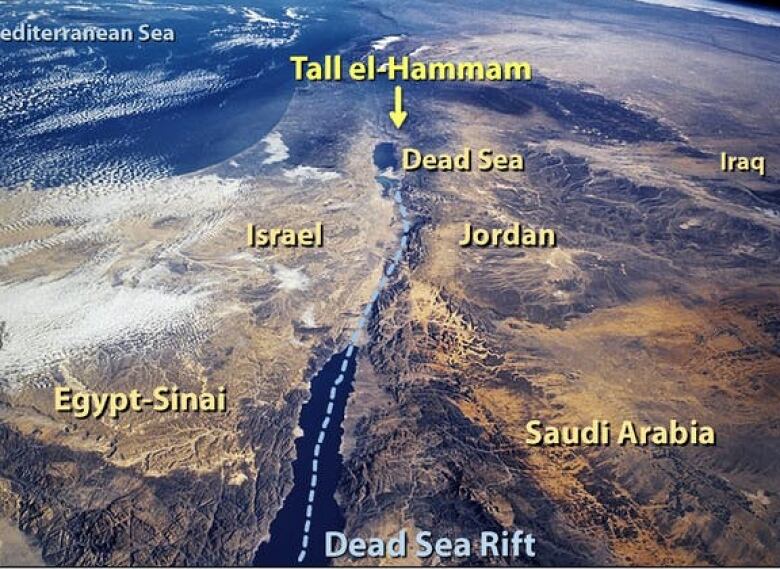A thriving town in the Jordan River valley was utterly annihilated by the explosion of a meteor 3,600 years ago, which produced a flash and shock wave that scorched and shattered buildings, animals and people.
That's the scenario painted by a large collaboration of archaeologists, earth and space scientists who have been studying the remains of the Bronze Age town at a site called Tall el-Hammam in Jordan, not far from the Dead Sea.
Before its destruction, Tall el-Hammam was a bustling town of perhaps 8,000 people, with mud-brick buildings and a four-story palace. There is evidence that the site of the town had been occupied for several thousand years.
Archaeologists have been excavating the ruins of the town for more than 15 years, revealing a rich history during its long occupation that included ruins from fires, warfare and earthquakes.
Their findings were published this month in the journal Scientific Reports.
The 'destruction layer'
But their excavations also revealed destruction that didn't have any ordinary explanation: a one-and-a-half-metre-thick layer of debris the team dubbed the "destruction layer," encompassing the whole settlement, and dated to 1650 BC. This layer showed signs of an incredibly violent event.
It included melted pottery and bricks, soot, melted plaster and metal, that only could have resulted from temperatures approaching 2,000 C. It also contained ruins of flattened buildings, including the town's palace and four metre-thick outer wall.
"The city was built with millions of mud bricks, in the walls, the ramparts, the buildings," space physicist Malcolm LeCompte, who was part of the research team, told Quirks & Quarks host Bob McDonald. "Much of the mud brick was just disintegrated and blown away off the upper stories of these structures into the next valley."

Most gruesomely, the debris also contained the remains of humans and animals that had been burned and torn apart.
"The human remains and bones were abundant. There's very few total skeletal remains. Those that do remain are pretty disarticulated — just shattered," said LeCompte. "It's pretty horrifying, actually."
The extreme temperatures and the widespread and violent destruction began to point the research team to a culprit. But microscopic examination of the debris also helped build the case. They found sand grains with unique cracks and fractures within them called "shocked quartz," which are often found in the debris from super-high velocity impacts, like those generated by a meteor strike.
This led them to conclude that the best fit for what they were seeing was an "air burst" by meteor likely composed of rock and ice. The object, perhaps 50 metres across, would have hit the Earth's atmosphere above the town travelling at perhaps 60,000 km/h. At that speed the atmosphere would have behaved as if it was almost solid, causing the meteor to explode violently.
"The evidence we have suggests that it was something like … a megaton-yield event in terms of its equivalent in atomic or nuclear bombs." said LeCompte.
On the ground, the flash of heat from the explosion would have caused hair and textiles to burst into flame, and melted metal and brick. Moments later, a shock wave would have hit, causing winds that researchers estimate reached speeds of up to 1,200 km/h — knocking structures in the town flat and killing every living thing in the town.
"The shock wave would have come and just torn them apart," said LeCompte.

It will happen again, LeCompte warns
The researchers point out that there are modern precedents for an event like this. In 1908 a similar-sized object is thought to have exploded in the atmosphere over Siberia, in what is known as the Tunguska event. It flattened 2,000 square kilometres of forest, and started a huge forest fire.
In 2013 a roughly 200-metre meteor exploded over Chelyabinsk in Russia, shattering windows and causing more than 1,000 injuries.
So far the team has found some material they think could be from the meteor, including tiny samples of rare metals often found in meteorites, but need to do more work to confirm their origin. LeCompte points out that excavation in the area can be difficult, particularly as much of the local landscape is currently occupied by Syrian refugees.
One intriguing, if speculative, possibility that the researchers have suggested is that the destruction of Tall el-Hammam might be the inspiration behind Biblical legends like the destruction of Sodom — in what is described as a "rain" of "fire and brimstone" — or the destruction of the walls of Jericho.
But LeCompte says those that look at Tall el-Hammam as a historical curiosity are missing the point. Instead, he said, they should look at it as a warning.
"The significance to its past pales in what it foretells for the future, because this is going to happen again," he said. The Tunguska event shows that the Earth can still be struck by destructive objects from space, and if something similar were to happen over a city or populated region, the devastation would be enormous.
"It just took it out in an instant, so that's a serious warning of what could happen — what will happen — in the future."
Written by Jim Lebans. Produced by Mark Crawley.
https://news.google.com/__i/rss/rd/articles/CBMi9AFodHRwczovL3d3dy5jYmMuY2EvcmFkaW8vcXVpcmtzL3NlcC0yNS1icm9uemUtYWdlLXRvd24tZGVzdHJveWVkLWJ5LW1ldGVvci1nbG9iYWwtd2FybWluZy1tYWtlcy1hbmltYWxzLXNoYXBlc2hpZnQtYW5kLW1vcmUtMS42MTg3NDI4L2FuY2llbnQtam9yZGFuaWFuLXRvd24tZGVzdHJveWVkLWJ5LWEtbWV0ZW9yLWJsYXN0LW1heS1oYXZlLWluc3BpcmVkLWJpYmxpY2FsLXN0b3JpZXMtc2NpZW50aXN0cy1zYXktMS42MTg3NDM20gEgaHR0cHM6Ly93d3cuY2JjLmNhL2FtcC8xLjYxODc0MzY?oc=5
2021-09-24 19:51:18Z
52781900051909
Tidak ada komentar:
Posting Komentar